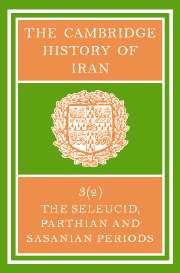Book contents
- Frontmatter
- PART 5 INSTITUTIONS
- PART 6 RELIGIOUS HISTORY
- PART 7 ART HISTORY
- PART 8 LANGUAGES AND LITERATURE
- 31 PARTHIAN WRITINGS AND LITERATURE
- 32(a) ZOROASTRIAN PAHLAVĪ WRITINGS
- (b) THE MANICHAEAN MIDDLE PERSIAN WRITINGS
- (c) MIDDLE PERSIAN INSCRIPTIONS
- 33 SOGDIAN LANGUAGE AND LITERATURE
- 34 KHOTANESE SAKA LITERATURE
- 35 KHWARAZMIAN LANGUAGE AND LITERATURE
- 36 BACTRIAN LITERATURE
- PART 9 BIBLIOGRAPHY
- Bibliography
- Index
- Index of Greek words
- References
(b) - THE MANICHAEAN MIDDLE PERSIAN WRITINGS
from PART 8 - LANGUAGES AND LITERATURE
Published online by Cambridge University Press: 28 March 2008
- Frontmatter
- PART 5 INSTITUTIONS
- PART 6 RELIGIOUS HISTORY
- PART 7 ART HISTORY
- PART 8 LANGUAGES AND LITERATURE
- 31 PARTHIAN WRITINGS AND LITERATURE
- 32(a) ZOROASTRIAN PAHLAVĪ WRITINGS
- (b) THE MANICHAEAN MIDDLE PERSIAN WRITINGS
- (c) MIDDLE PERSIAN INSCRIPTIONS
- 33 SOGDIAN LANGUAGE AND LITERATURE
- 34 KHOTANESE SAKA LITERATURE
- 35 KHWARAZMIAN LANGUAGE AND LITERATURE
- 36 BACTRIAN LITERATURE
- PART 9 BIBLIOGRAPHY
- Bibliography
- Index
- Index of Greek words
- References
Summary
The impact of Manichaeism on Middle Iranian literature has already been considered in connection with Parthian; but although Mānī was himself of Parthian blood, Middle Persian was in fact the first language which the prophet used in seeking to spread his faith in Iran. The reason for this was that the political situation had changed greatly there during his own boyhood. He was born under the last of the Arsacids, in a.d. 216; but some eight years later Ardashīr Pāpakān, founder of the Sasanian dynasty, overthrew Ardavān V, and the imperial power passed from Parthia to Persia once more. Accordingly, when Māanī resolved to make his teachings known to the King of Kings, it was at the court of Ardashir's son, Shāpūr I, that he presented himself. He brought with him, it seems, a work dedicated to this ruler, entitled Shābuhragān “the Book of Shāpūr”. In this he had set out a summary of his new doctrines; and some pages of it survive. Whether Mānī himself wrote the actual Middle Persian version is doubtful, for years later, after long sojourn at the Sasanian court, he still chose to be accompanied by an interpreter at an audience with Shāpūr's son, Bahrām I; and though this may have been a largely unnecessary precaution, taken because his life was then at stake, nevertheless the action does not suggest that he was an assured linguist. Probably, therefore, as a young man he wrote the Shābuhragān in his mother-tongue, Aramaic, and had it translated into Middle Persian.
- Type
- Chapter
- Information
- The Cambridge History of IranSeleucid Parthian, pp. 1196 - 1204Publisher: Cambridge University PressPrint publication year: 1983



